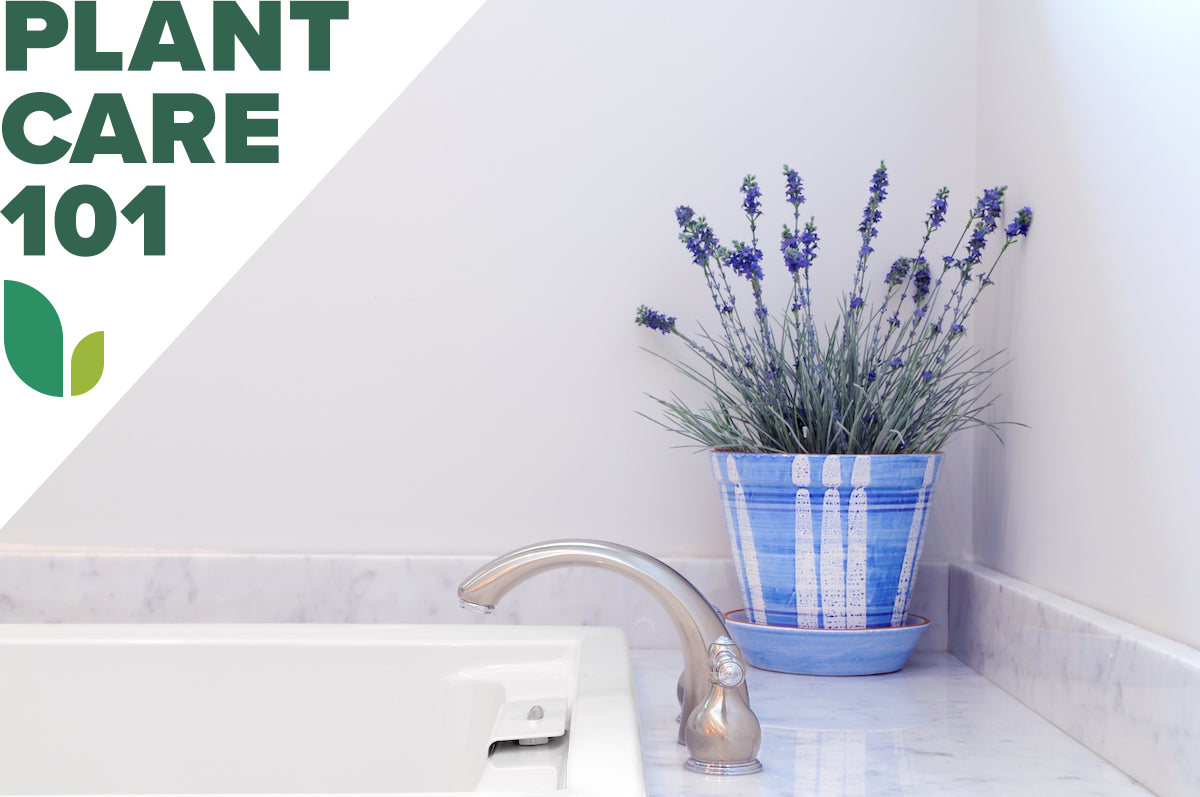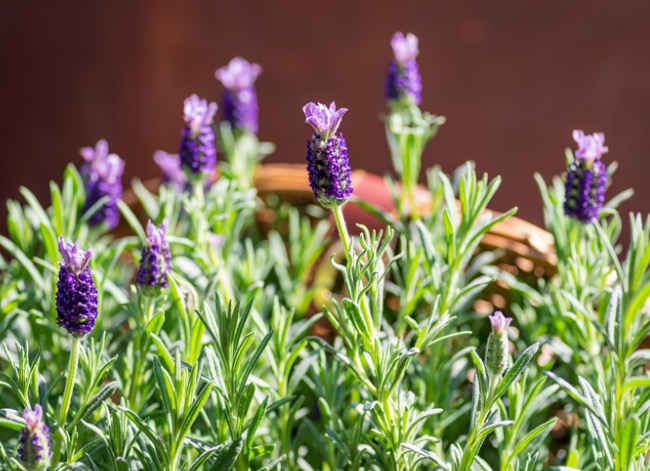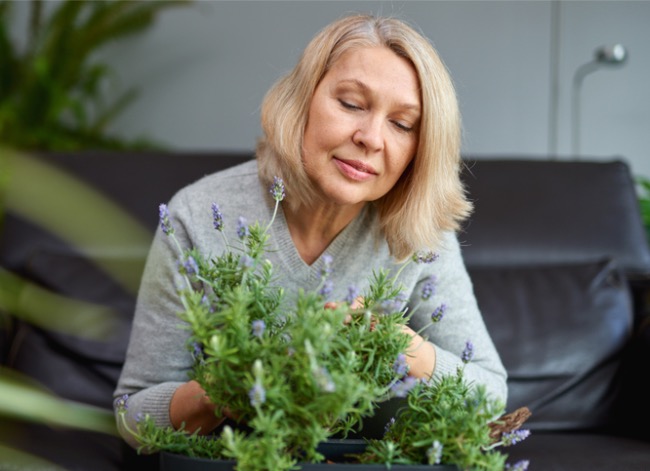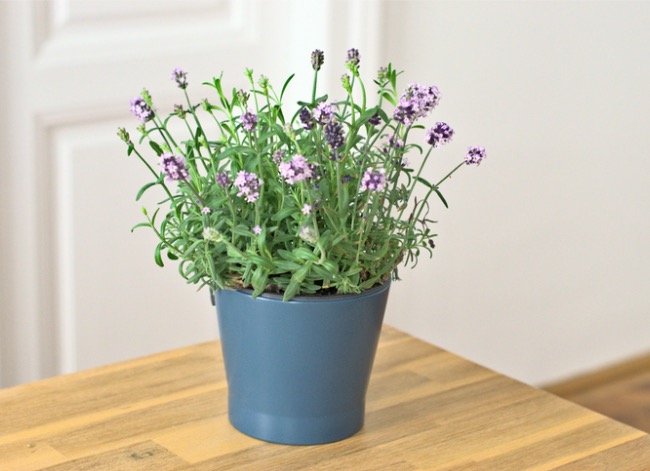

We may earn revenue from the products available on this page and participate in affiliate programs. Learn More ›
Pollinators such as bees and butterflies appreciate lavender in the landscape because it is a rich source of nutritious pollen and nectar. Gardeners, florists, and aromatherapy enthusiasts enjoy the delicate flowers too, along with the added benefit of deliciously scented essential oils. Those in mild climates enjoy this perennial herb in the garden year-round, but if you don’t have outdoor garden space or live in a cold climate, it is possible to grow lavender inside.
This plant makes an excellent container specimen for patios and balconies, but will not tolerate extreme cold. Growing lavender indoors is a good strategy for overwintering, but may not be in the plant’s best interest as a permanent, year-round situation. If you are considering adding this popular low-care herb to your plant collection, read on to learn more about lavender plant care.
Indoor Lavender Care at a Glance
Common Name: Lavender
Scientific Name: Lavandula spp
Soil: well draining
Light: high
Water: medium to low
Food: slow release or liquid plant food
Temperature and Humidity: 40 to 90 degrees Fahrenheit, low to moderate humidity
Propagation: seed or cuttings
Safety: low allergen, low level toxicity in animals
Lavender Plant Characteristics
Lavenders are perennial herbs that belong to the plant genus Lavandula. These plants are compact, sprawling sub-shrubs with grayish-green foliage and long flowering shoots. The tough, narrow leaves may be either simple or delicately lobed. The flower shoots are borne at the stem tips, with flowers in shades of blue, purple, lilac, or white.
Lavender essential oil is commonly used in aromatherapy. The sweet, pungent fragrance of the oil promotes calm and wellness. It is used to reduce stress and promote relaxation. Although there is no FDA approval for lavender as a medical treatment, the herb has shown effectiveness against anxiety, fungal infections, wounds, and even hair loss.
There are at least 45 different species of lavender, and more than 450 varieties found in warm, temperate regions of the world. The most readily available cultivars come from the species L. angustifolia, L. stoechas, and the hybrid L. x intermedia, which originated in the Mediterranean region. They grow best in places with hot, dry, or semi-arid growing seasons and mild winters, and are well suited for container gardening. Ahead, learn how to take care of a lavender plant.
Related: 13 Plants You Can Winter Indoors

Types of Lavender Plants
Lovers of lavender can find plenty of variety to suit their climate or indoor conditions. Likewise, some lavender plants are bred for more aromatic flowers, and some for deeper color. These are some common types:
Lavandula angustifolia, also known as English Lavender or Common Lavender
- ‘Hidcote’ is highly prized for its abundant dark purple blooms that contrast with its blue-green foliage.
- ‘Munstead’ is a compact form that works well where space is limited.
Lavandula stoechas, commonly known as French Lavender, Spanish Lavender, or Butterfly Lavender
- ‘Anouk’ is a vigorous grower with especially showy purple flowers.
- ‘Ballerina’ produces plump, purple flower heads topped by long-lasting white petals.
- ‘Regal Splendor’ grows bright green foliage and spectacular purple-violet flowers.
Lavandula x intermedia, also known as Lavandin
- ‘Grosso’ is known for its vigorous growth, gray-green foliage, and dark blue flowers.
- ‘Provence’ is one of the most intensely fragrant lavenders, with long spikes of lavender-blue flowers that are frequently used for cut arrangements.
- ‘Seal’ produces an abundance of rich purple flowers that contrast nicely with its gray-green foliage.
Selecting Soil for Lavender Plants Indoors
Potted lavender plants need a well-draining soil mix with a neutral or slightly alkaline pH. Create your own blend with high-quality, general-purpose potting soil, perlite, and garden lime. Mix three parts potting soil with one part perlite for a soil structure that will retain adequate moisture while ensuring proper drainage and good root development. Add a few tablespoons of garden lime per gallon of soil/perlite mix to tip the pH scale slightly alkaline for optimum nutrient usage.
Start new lavender plants in 8-inch pots for the first year. Repot in the early spring, just prior to moving them outside to the patio or balcony for the growing season. Lavender grows best when the pot just fits. When repotting, choose the next container size up. Avoid sizing up to a pot that is too big.

The Right Light
Lavender needs lots of direct sunlight for top performance. Without adequate sunlight, the plant will not flower, will grow weak and spindly, and will become susceptible to disease and pest infestation. Through the growing season, it is best to move lavender plants outdoors where they will receive direct morning sunlight and perhaps shade in the afternoon. When the weather cools in the fall, bring them indoors.
Indoors, lavender should get as much light as possible. Place the pot in front of a south-facing window with at least 3 hours of direct sunlight a day. Rotate the pot each week so that all sides of the plant receive some direct sunlight. When making the transition from overwintering indoors to its outdoor summer location, start with just an hour or two of direct, outdoor sunlight and gradually increase to a half-day or more over the course of 2 weeks.
Related: Does Your Home Smell Funny? 12 Odors That Could Mean Big Trouble
Watering Lavender
Plant size, pot size, temperature, and many other factors affect watering needs. Check for watering every few days by touching the soil. Water lavender plants when the soil surface feels dry. Do not allow the soil to dry out so thoroughly that it pulls away from the pot edges.
When watering lavender, it may be helpful to move the pot to a sink in order to contain the excess water. Be sure to soak the roots completely. Thoroughly hydrate the soil mixture, then let it drain completely. Do not allow water to remain in the plant saucer. Watering too frequently or letting the soil remain too wet can lead to root rot.
Fertilizing Lavender Plants
Lavender plants are not heavy feeders, but they do require some basic nutrition. New potting soil typically includes a small amount of fertilizer or compost. For a healthy plant with beautiful blooms, be sure to fertilize with either a time-release fertilizer or with an all-purpose liquid plant food. Apply time-release fertilizer when repotting in late winter or early spring, and again in midsummer. If you prefer liquid, follow the manufacturer’s instructions for monthly feeding.
Setting the Temperature and Humidity
Indoor lavender plants need good ventilation and air circulation, but should not be placed in the direct flow of forced-air heat or air conditioning. The ideal overwintering temperature range is 65 degrees Fahrenheit during the day and 45 degrees at night for the winter season.
Do not attempt to move the plant outdoors in spring until all danger of frost has passed. Then, slowly harden off the plant to avoid shocking it. First, move the plant to a semi-shaded outdoor location for just an hour or two. Gradually expose the plant to outdoor conditions by adding a little more time each day during a 2-week transition period.

Propagating Lavender
You can grow new lavender plants either from seeds that you purchase or harvest from your own plants, or by propagating stem cuttings. Here’s how to do it.
How to grow lavender from seed
If you’re interested in growing lavender from seed, you will need 30 to 90 days and a warm indoor space. Fill shallow seed trays with premoistened seed starting mix. Sow fresh lavender seeds on the soil surface and soak them with a water mister. Do not cover the seeds with soil. Cover the seed tray with a plastic dome and place it in a sunny windowsill. Remove and replace the humidity dome daily to eliminate stagnant air, and mist as needed to keep the tray well moistened.
The seeds will germinate slowly, in 1 to 3 months. Let them grow another 2 months before transplanting into individual pots.
How to grow lavender from cuttings
Lavender cuttings root quickly in water or soil. To root them in water, fill a small glass or jar with 3 inches of water. To root them in soil, prepare 4-inch containers with lavender potting soil as described in the Selecting Soil For Lavender Plants Indoors section.
Take 4-inch stem-tip cuttings from healthy new growth in the late summer or early fall. Remove all foliage from the bottom 2 inches of the stem and gently scrape some bark from the stem. Place the prepared cuttings in water or dip them into rooting hormone and stick them into soil-filled pots. Move the jar or pots of cuttings to a sunny location. Roots will develop within 3 to 6 weeks.
Related: 14 Old-Fashioned Flowers That Still Look Great in Today’s Home Gardens
Safety Considerations
Lavender plants are considered low in allergens and pose low toxicity concerns for humans. The oils may be overwhelming to some with fragrance sensitivity, in which case it is best to avoid the highly fragrant hybrids. But few incidents of human allergy or illness are reported.
Lavender poses a low-level toxicity concern for pets. Dogs and cats that have eaten large enough amounts of the foliage have been known to experience gastrointestinal blockages. As always, use caution and your best judgement when bringing a new plant into your home.
Potential Pests and Diseases
Given the proper growing conditions, diseases or pests cause no major damage to lavender plants. Chronic overwatering or compacted soil may lead to root rot. Inadequate sunlight results in spindly growth that may attract whiteflies, aphids, or spittlebugs, especially during the growing season.
Avoid these problems by planting lavender in coarse, well-draining soil, watering only when needed, and growing the plant in direct sun exposure.

FAQs About Indoor Lavender Plant Care
Still curious about growing lavender? Find more answers to some of the most common questions ahead.
It takes 30 to 90 days to germinate lavender seeds, then another 2 months to grow the plants to transplant size. Lavender cuttings typically produce roots within 6 weeks or less.
Lavender needs at least 3 hours of direct sunlight a day. If the bedroom has an unobstructed south-facing window, the plant can do well. There is no evidence that keeping the plant or its cuttings can aid in sleep, but the plant can add beauty and fragrance to the room.
The scent of lavender oil, abundant in the foliage of the plant, is associated with a reduction in anxiety and stress. Its fragrance is purported as calming when infused in personal care products or scented oils.
Lavender has long been used as a gentle sedative for reducing nervousness, restlessness, sleep disorders, depression, and headaches. Outdoors, the plant is known to repel mosquitoes and other insects (but attract bees and butterflies).
The scent of lavender’s essential oils is more pronounced when the plant grows in low-organic soil with low fertility.
Lavender plants need bright sunshine, at least 3 hours per day, and coarse, well-draining soil. Only grow lavender in a room with ample natural sunlight. If you want to extend the time in which you can enjoy the fragrance, cut flower stems from the lavender when most of the stems have at least half of their buds open in bloom.
Looking for more beginner-friendly plants? Check out our guides on caring for jade plants, aloe vera plants, and yucca plants.
